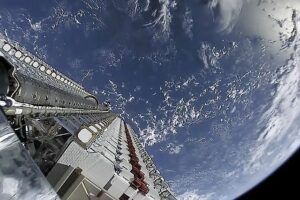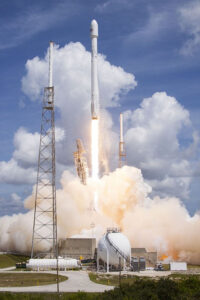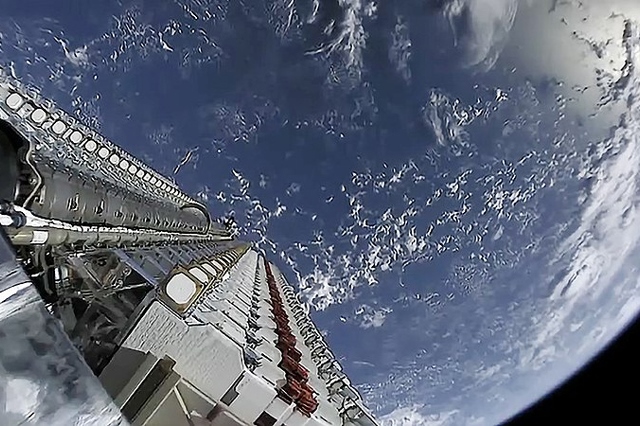The opportunity for billions of people across the globe to have access to high-speed satellite internet, at a reasonable price, may soon become a reality. Elon Musk, who took his position amongst the world’s richest by upending the global auto industry and disrupting aerospace giants with reusable rockets, is now setting his sights on another industry dominated by entrenched incumbents. He’s jumping in the ring for a share of the high-speed internet market. Musk’s company SpaceX plans to make Starlink satellite broadband available to anyone from anywhere in the world. His initial goal is to provide high speed internet to locations where access has been unreliable, expensive, or simply unavailable. Question is, will his quest for a share in the broadband market end there?

Elon Musk – business magnate, industrial designer and engineer, Musk is the brainchild behind numerous disruptive companies including Tesla, SpaceX, The Boring Company, Neuralink, and OpenAI.
Starlink – Low Earth Orbit (LEO) Satellite Internet
Starlink is a mission to fill the Earth’s lower orbit with a constellation of satellites that will work in tandem with ground receivers, to beam broadband internet to happy customers. All of these satellites will be much lower than traditional satellites, orbiting at an operational altitude of roughly 550 km (340 miles) – promising higher bandwidth and lower latency than traditional satellite internet (so no more buffering).
Traditional satellites maintain a geosynchronous orbit at approximately 35,000 km (22,000 mile) above the Earth’s surface. Although these high orbit satellites are able to maintain a constant position above the Earth – providing uninterrupted service – their high altitude also means slower service since data has a longer distance to travel.
Since Starlink satellites operate at a lower orbit, they move much faster than higher geostationary satellites, and have a smaller cone of coverage. This means that ground receivers need to hop constantly from one satellite signal to another. This is helped by the sheer number of satellites covering the sky. SpaceX has a plan to release a total of 12,000 Starlink satellites, half of them by the end of 2024. And Musk would like to add an additional 30,000, bringing the total of 42,000 satellites. *To put this in perspective, that is roughly 15 times the number of operational satellites in orbit today.

As far as satellite specifications go…
- Starlink satellites have a mass of about 260 kg (550 lbs), and the dimensions equivalent to a large vending machine.
- Starlink satellites will also be equipped with autonomous collision avoidance that utilizes inputs from the Department of Defense’s debris tracking system to perform maneuvers and avoid collisions with space debris and other spacecraft.
- Starlink satellites feature a single solar array powered with efficient ion thrusters that enable them to orbit raise, maneuver in space, and deorbit at the end of their useful life.
- In the future, each satellite will connect with neighboring satellites via laser beams, further strengthening the network.
Advantages Of LEO Satellite Broadband Vs. Alternatives
While many are celebrating Elon Musk’s plan to bring broadband internet to hard-to-reach places, a few existing players in the internet market, may have reason to be worried. The fact is, Spacelink’s low Earth orbit satellites offer distinct advantages over both terrestrial internet and existing satellite broadband.
Terrestrial Internet Service
In rural areas, and places with underdeveloped internet networks – like Africa, the Middle East, and Asia – laying long cable runs into remote regions can be costly given the number of potential customers. To compensate, telecoms sometimes build out wireless signals in those areas, but that is also costly. Therefore, there is a good chance that Starlink will absorb all the internet customers who live in low bandwidth areas, reducing revenue and potential new markets for terrestrial internet companies.
In addition, since Starlink satellites operate at a relatively low altitude of roughly 550 km (340 miles) above Earth, such a short distance means a speed advantage over long stretches of fiber optic networks. So even when accounting for transmitting from the planet and back, the faster transmission speeds from satellites will give Starlink a latency edge. And while the number of Starlink customers will be limited in densely populated urban areas, this will still give the company a competitive advantage over telecoms in rural areas.
High Orbit Geostationary Satellites
Starlink’s low Earth orbit satellite broadband, has an even bigger advantage over traditional satellite broadband. The reason is, current satellite internet providers use high orbit geostationary satellites that are orbiting over 35,000 km (22,000 miles) above the surface of the Earth – significantly higher than the 550 km (340 miles) orbital altitude of Starlink. It’s this difference that creates the first major advantage for LEO satellite broadband: latency. Customers will clearly prefer the significantly shorter lag times of Starlink over the competitors.
 And then you have the challenge of how much bandwidth a single satellite can handle at once, which affects the upload and download speeds for everyone sharing the geostationary satellite. Starlink, on the other hand, will have a constellation of thousands of satellites, meaning less pressure being put on any single one.
And then you have the challenge of how much bandwidth a single satellite can handle at once, which affects the upload and download speeds for everyone sharing the geostationary satellite. Starlink, on the other hand, will have a constellation of thousands of satellites, meaning less pressure being put on any single one.
Starlink Filling Several Niches
With its distinct advantages over both terrestrial internet and traditional satellite broadband, Musk is already targeting several niches for Starlink’s initial market. He has said he’s just trying to grab a small percentage of a trillion-dollar-a-year telecommunications industry around the world. If successful, Starlink could net tens of billions of dollars in annual revenue. Starlink is angling for a piece of the following markets…
Rural Customers
First and foremost, Starlink will be targeting rural customers living in remote parts of the world. An estimated 40 percent of the world’s population still does not have reliable internet service due to the prohibitive costs of laying underground fiber optic cables in rural areas. That’s roughly 3 billion people!
Considering that so many modern conveniences rely on an internet connection – things such as smartphones, smart televisions, streaming services, video games, and social networking – having a reliable, readily available, and easily accessible internet connection is something even the poorest and most remote parts of the world are starting to demand.
In-Flight WiFi And Maritime Shipping
Another big market for Starlink’s satellite broadband is in-flight WiFi and maritime shipping. Supplying high speed internet to airlines, cruise ships, and commercial shipping is a lucrative market. One that currently suffers with high-cost, high latency and low bandwidth internet from traditional satellite internet providers.
United States Military
Starlink also has a lucrative customer in the many branches of the United States Military who want to make use of new low-Earth orbit satellite constellations. This is because the large geostationary satellites already in use for military communications are vulnerable. Starlink’s system, on the other hand, is designed to continue onward with gaps in the link – something geostationary satellites can’t do.
High Frequency Stock Traders
If Starlink proves to be as low latency as promised, it could be a huge advantage for high frequency stock traders. Starlink’s projected 25-35 ms latency is faster than anything on the market today. And in businesses where every millisecond counts, this could be another, albeit small, market niche.
The “Space” Unkind To Startups
Numerous satellite broadband companies have failed in their attempt to make high speed internet available from anywhere in the world. They promised great things, but in the end they burnt through billions in cash before they cutting their losses and packing up. Examples include Leosat, Skybridge, Globalstar, Iridium 1, Teledesic, and OneWeb among others. When asked in an interview if he was “focusing on making Starlink work first [in light of all the other failures],” Musk simply replied, “not bankrupt.”
SpaceX Succeeding Where Others Have Failed
 While other companies have taken a shot and failed, SpaceX’s Starlink endeavor has had a greater chance of success from the outset. Simply put, SpaceX owns the rocket technology. They can can put their own satellites into orbit, while failed startups were paying hefty cargo bills for their satellites. In addition, SpaceX has been a leader in implementing new technology, standardizing parts and processes, and in developing a compact Starlink design resulting in less payload per satellite. All this helps drive down their cost, allowing SpaceX to launch more of their own satellites into orbit. This puts them in a position to disrupt the whole satellite internet industry by virtue of Starlink’s potential scale. And now that they have paying customers, the future for Starlink looks very bright indeed.
While other companies have taken a shot and failed, SpaceX’s Starlink endeavor has had a greater chance of success from the outset. Simply put, SpaceX owns the rocket technology. They can can put their own satellites into orbit, while failed startups were paying hefty cargo bills for their satellites. In addition, SpaceX has been a leader in implementing new technology, standardizing parts and processes, and in developing a compact Starlink design resulting in less payload per satellite. All this helps drive down their cost, allowing SpaceX to launch more of their own satellites into orbit. This puts them in a position to disrupt the whole satellite internet industry by virtue of Starlink’s potential scale. And now that they have paying customers, the future for Starlink looks very bright indeed.
Hurdles Yet To Overcome
Even with the early successes, Starlink still has some hurdles that the team at SpaceX have to overcome.
High Cost Of Ground Terminals
Currently a ground terminal (antenna and router) for Starlink costs $499. This is over and above the $99 per month service fee. For some this is a small expense, but for the broader population living in rural regions of the world, this is a prohibitive amount. For example, Teldesic – a similar LEO satellite internet effort to Starlink – attempted to accomplish much the same goal. But a major factor in their failure, was due the high cost of supplying ground terminals to customers. Therefore Elon and his team at SpaceX need to find a way to make their ground terminals and antennae cheap and accessible to everyone.
To deal with the problem of costly ground terminals and receivers, SpaceX has plans to simplify the terminals. They are designing a more slender Starlink receiver that can simply be plugged in. Eliminating the clunky antenna and dish drives down the cost, while making the user experience – the setup – much more hassle free.
“Mega-Constellation” Will Hinder Observational Astronomy
There has also been concerns about the impact on astronomical observations. There are many astronomers who state that the presence of such a high concentration of satellites will ruin their observations because of the light pollution they emit as they race around the atmosphere. Satellites reflect the sunlight and shine it back towards Earth, creating a visual obstruction that looks like a blanket of bright moving stars. And unfortunately, these satellites are most visible in the night sky right before dawn and right after dusk, which is the exact time that astronomers are hunting for new planets, black holes, comets and asteroids, and most importantly, near-Earth objects.
SpaceX has been working with astronomers to address these concerns and decrease the brightness of their satellites. They are adopting strategies like DarkSat, in which they paint sections of the newer satellites with a black anti-reflective coating. They are adjusting the orbit orientation to minimize how the satellite will catch and reflect sunlight towards the Earth’s surface. They are even adding a sun shade – a VisorSat – to the satellite to help block reflections.
Astronomers say that while these are great improvements, even more work needs to be done. There are still concerns that Starlink’s satellite constellation will ultimately impact visual and radio telescope observations. But to SpaceX’s credit, they continue to take proactive steps to address the issue.
Risk Of Too Much Space Debris
Currently there are nearly 6,000 satellites circling our planet (of which 46% are operational). That means that in less than a decade, the Starlink network will essentially triple the number of satellites in Earth’s orbit. And if SpaceX moves forward with an additional 30,000, you can probably understand why a lot of people are concerned about overcrowding and space debris. With so many satellites circling in a dense configuration around Earth, there’s an elevated risk that Starlink satellites could collide with each other or with other satellites. The more collisions, the more debris, and soon the problem could cascade out of control in an phenomenon known as the Kessler syndrome. Those concerned with such a large constellation of low orbit satellites are lobbying the FCC to rein in SpaceX and more strictly regulate low-Earth orbit. That could make it more difficult and more expensive for the company to deploy their planned 42,000 satellites.
In order to address this risk, SpaceX is equipping Starlink satellites with autonomous collision avoidance systems and a single solar array powered with efficient ion thrusters. These thrusters will enable each satellite to orbit raise, maneuver in space, and deorbit at the end of their useful life. So with a targeted lifespan of 5-7 years, SpaceX plans to propulsively move Starlink satellites to a disposal orbit, in which they will get pulled down to Earth by atmospheric drag and reenter the atmosphere within approximately one year after completion of their mission. About 95% of each satellite’s parts will disintegrate in the Earth’s atmosphere as they deorbit. And thanks to the low operational altitude of Starlink satellites – roughly 550 km (340 miles) above Earth’s surface – SpaceX’s disposal plan is actually quite viable. A feat harder to pull off for traditional satellites circumnavigating the globe at much higher altitudes.
Global Compliance
A final hurdle that is separate from the engineering obstacles, is that of global compliance. Simply put, SpaceX is a company based in the USA. This means the company will need to attain approval from a multitude of nations and regions in order to market or license their Starlink ground stations in respective countries. It might be reasonable to expect nations like China, Russia, and Iran to deny the right to operate Starlink ground stations within their sovereign borders – whether is be to protect domestic interests or national security.
Could Starlink Disrupt The Telecoms?
Although Elon Musk downplays Starlink’s threat to the telecoms, there’s still reason for the telecommunications industry to be nervous. Sure, while 5G will likely rule the roost in high density urban areas, its the medium populated rural towns and communities where telecoms have a lot to lose. In many rural parts of the world, internet users have little choice over their service provider. Often the telecoms have a monopoly or oligopoly, and can get away with charging excessively high rates to their customer base. So with Starlink entering the market as a direct competitor, telecoms will be forced to slash their prices and accept lower profit margins.
Also, its important to remember how Elon sets goals with his long-term master plans. To draw parallels with Tesla Motors, they first went after the higher end of the market with a high performance electric sports car called the Tesla Roadster. Then they gradually brought the price of new models down, entering the broader market. Likewise with Starlink, it would be remiss to think that Musk simply has his sights set on remote clientele who only make up a smaller part of the internet market. With advancements in technology that are certain to happen over the next decade or two, there’s no reason to believe that Starlink won’t encroach evermore into the telecom’s space. There’s even the potential of Starlink eventually swallowing the telecoms as it becomes a bigger and bigger player in the market.
Project Kupier – A Serious Competitor To Starlink?
SpaceX isn’t the only company capable of lifting its own satellites into orbit. Amazon subsidiary Project Kupier, is another ambitious project set on creating a LEO satellite broadband network. Similar to Starlink, Project Kupier has access to it’s own in-house delivery system via Jeff Bezos’ Blue Origin space rocket company. Which means Project Kupier has the potential to rival Starlink in both capacity and operating scope (they have plans to put around 3,236 satellites into orbit). With the help of Blue Origin’s reusable launch vehicles and Amazon’s huge cash reserves, the race for LEO satellite broadband is set to heat up.
Profiting From The Low Earth Orbit (LEO) Satellite Broadband
With almost half of the global population still lacking reliable and/or affordable internet access, there are going to be some big winners – and big losers – as the world gains access to LEO satellite broadband. Who will be the winners and who will be the losers?
Winners (LEO satellite internet)
Starlink – On September 28, 2020 Elon Musk tweeted… “We will probably IPO Starlink, but only several years in the future when revenue growth is smooth & predictable.” Thus far, there is no confirmed date for the Starlink IPO.
Kuiper Systems – a subsidiary of Amazon that intends to deploy a network of LEO satellites that will provide low-latency, high-speed broadband connectivity to underserved communities around the world. The enterprise is also referred to by its project name Project Kuiper.
Losers (companies with a large rural customer base)
Geostationary Satellite Internet
Hi Cost Telecoms






